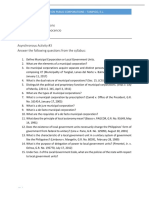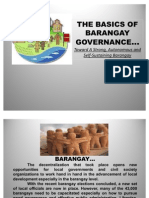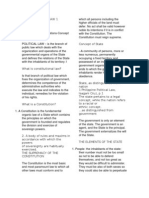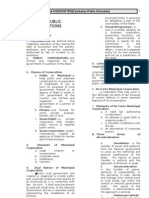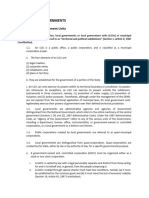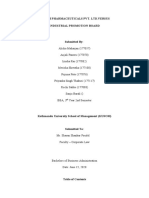Notes in Local Government of The Philippines
Notes in Local Government of The Philippines
Uploaded by
stephenkari207Copyright:
Available Formats
Notes in Local Government of The Philippines
Notes in Local Government of The Philippines
Uploaded by
stephenkari207Original Title
Copyright
Available Formats
Share this document
Did you find this document useful?
Is this content inappropriate?
Copyright:
Available Formats
Notes in Local Government of The Philippines
Notes in Local Government of The Philippines
Uploaded by
stephenkari207Copyright:
Available Formats
Notes in Local Government of the Philippines
P – eople
E – mergency power to the President
T – arrif
A – dministrative bodies
L – ocal Government Units
Province Barangays
LGU
Municipalities Cities
Delegates to the LGU:
Police Power
Eminent Domain
Taxation
Local Government – a political subdivision of a nation or state which is constituted by law and has substantial control of
local affairs with officials elected or otherwise locally selected.
It is important to have a local government to regulate local affairs in the locality or area of jurisdiction rather than by
central authority.
History of Local Government in the Philippines
Pre-colonial: Datu and Council of Elders
city-states (no higher government)
Spanish Period: King Philip II of Spain and Governor-General
Barangays = Barrios
Datu = Cabeza de Barangay
No legislative, because laws were made in Spain, only cascaded in PH
“Cortez”- acts as legislative department
First PH republic: independent “de facto” government (illegitimacy) not in accordance with the law
3 governments considered “de facto”: 1. De facto proper (Corazon administration)
2. Government of paramount force
3. Independent government
Owned by: Regine Laguilles
Disclaimer: This document serves only as a reviewer and shall not be used in any academic dishonesty act. If used for it
beyond owner’s sight and control, the owner shall not be liable for any consequences that may arise.
American period: still centralism
Commonwealth (interrupted by Japanese)
1935 Constitution, Art. VII, Sec. 10 – Philippines shall exercise general supervision over local
government.
Second PH republic: government of paramount force (de facto still)
Third PH republic: De jure (legitimate); there is 1987 Constitution.
Fourth PH republic: Martial Law
January 17, 1981 – Martial Law was lifted
Corazon Aquino – de facto President (due to snap election)
Fifth republic: Decentralization
Art. X, Sec. 5, 1987 Constitution
“Imperium in imperio”
LGU taxes: amusement, sales, real properties, etc.
Mandanas-Garcia ruling: Full devolution
GENERAL PRINCIPLES
Corporations: LGU’s are artificial/juridical persons
Elements of Municipal corporations:
Legal creation/incorporation
Corporate name (e.g. City of Cebu)
Inhabitants
Territory
3 KINDS: 1. Public corporations
Classifications of Public corporations:
a. Municipal corporations – charter, assist civil government; object is public, incidents are private.
Dual Nature and Functions of Municipal corporations:
1. Governmental (public/private) functions
2. Proprietary (private, patrimonial, corporate) functions
b. Quasi- corporation – are created by the state for a limited purpose; private of nature, incidents are public.
Test to determine Public/Private Corporations:
1. The purpose of its creation
2. The relationship of the corporation to the state
Constituents
Ministral Government Functions
Owned by: Regine Laguilles
Disclaimer: This document serves only as a reviewer and shall not be used in any academic dishonesty act. If used for it
beyond owner’s sight and control, the owner shall not be liable for any consequences that may arise.
Doctrine of parens patriae
2. Private corporations
3. Quasi-Public corporations (Aleco, Water districts) – private corps. rendering public services.
Special classes: De facto corporations, Corporations by prescription, Corporations by estoppel
a. De facto corporations - consent of the state is implied; requirements not substantially complete.
b. Corporations by prescription – common law principle; presumption arises when charter granted to their predecessors;
lawful and rightful; no papers in SEC.
c. Corporations by estoppel – would not be permitted to deny the fact the existence of the corporation.
Sources of Power of PH Local Government
1. 1987 Constitution, Art II, Sec. 25, Art. X, Sec. 5-7
2. Local Government Code of 1991 (R.A. 7160)
3. Their Charters (statute creating them)
4. Other laws, decrees, orders (e.g., E.O. 138 of Pres. Duterte re: Full Devolution)
Powers of LGU: express, implied, inherent, governmental, proprietary, intramural, extramural, mandatory or directory,
and ministerial or discretionary
Under the Code and the IRR, LGUs may exercise four (4) general kinds of power:
1. Those that are expressly granted to them.
2. Those that are implied from those granted to them.
3. Those that are necessary, appropriate, or incidental for their efficient and effective governance.
4. Those that are essential to the promotion of the general welfare of their inhabitants.
The Concept of Local Autonomy, Decentralization, Devolution, and Deconcentration
NATIONAL-LOCAL GOVERNMENT RELATIONS: AN OVERVIEW
Centralization – means that the authority, responsibility, and ability to perform the basic functions of an organization are
concentrated in a central governing unit.
Functions include a. representing the organization; b. determining its goals; c. making decisions.
National or Central
Government
LGUs
People
Decentralization – dispersal of authority and responsibility and the allocation of powers and functions from the center or
top level of government to the basic levels, from the central government to the regional bodies or special purpose or
authority, or from the national to the sub-national levels of government.
Forms: Decentralization, Devolution, and Privatization
Deconcentration: administrative decentralization (e.g., regional to field office)
Owned by: Regine Laguilles
Disclaimer: This document serves only as a reviewer and shall not be used in any academic dishonesty act. If used for it
beyond owner’s sight and control, the owner shall not be liable for any consequences that may arise.
Devolution: political decentralization (transfer of power to political subdivisions of the State)
Privatization: delivery of certain government functions may be delegated to a non-state institution such as business
corporations and non-government or people’s organizations.
LOCAL AUTONOMY – ability of different tiers of local governments for self-government.
There are at least four (4) requirements that must be in place before local government units may enjoy autonomy:
1. A set of locally elected officials, at least at the legislative level, through which the local government unit can
make its decisions and promulgate laws relevant to the needs of the community.
2. A well-defined area of responsibility i.e., they must know what exactly is expected to them if they are to take
charge of delivering basic services.
3. A clear delineation of nature of local-national government relations
4. Ability to generate local resources that it can be utilized to finance programs.
Five (5) Measures of Autonomy
1. Self-determining in terms of goals and functions;
2. Inclined to exercise initiative, leadership, and discretion in decision-making and action;
3. Self- reliant in resources and strategies;
4. Open to local participants; and
5. Responsive and accountable to local constituents.
Tiers of Philippine Local Government
National
Highly Urbanized City Province
Barangay Municipality Component City
Barangay Barangay
Owned by: Regine Laguilles
Disclaimer: This document serves only as a reviewer and shall not be used in any academic dishonesty act. If used for it
beyond owner’s sight and control, the owner shall not be liable for any consequences that may arise.
You might also like
- Local Government Code ReviewerDocument93 pagesLocal Government Code Reviewerjie94% (16)
- Outline in Constitutional Law 1 (Cruz)Document8 pagesOutline in Constitutional Law 1 (Cruz)Arvin Antonio Ortiz93% (44)
- Btf2000 Australian Corporations Law Hd90 NotesDocument128 pagesBtf2000 Australian Corporations Law Hd90 NotesJun LeNo ratings yet
- Nachura Notes Local GovernmentsDocument34 pagesNachura Notes Local GovernmentsNowhere Man100% (18)
- DL PA 251 Local GovernanceDocument9 pagesDL PA 251 Local GovernanceYnohtna Asogadnab100% (1)
- Nature and State of Local GovernmentDocument68 pagesNature and State of Local Governmentmarielkua100% (1)
- RoyDocument3 pagesRoySaroja RoyNo ratings yet
- Tender Guideline For Technical Submittal and Commercial Submittal Procedure For Chilled Water Line Upgradation Project at 1241101Document5 pagesTender Guideline For Technical Submittal and Commercial Submittal Procedure For Chilled Water Line Upgradation Project at 1241101afzal_aab100% (1)
- Philippine Constitution Unknown 66Document88 pagesPhilippine Constitution Unknown 66Yna GeneraoNo ratings yet
- Laws on Local Government MIDTERM NOTESDocument6 pagesLaws on Local Government MIDTERM NOTESMs NoviceeNo ratings yet
- GN Poli - PubcorpDocument47 pagesGN Poli - PubcorpKia BiNo ratings yet
- Adsum Notes Public Corp FINAL (Part1to4)Document39 pagesAdsum Notes Public Corp FINAL (Part1to4)Raz SP100% (2)
- CHAPTER 1-Introduction To Local GovernmentDocument22 pagesCHAPTER 1-Introduction To Local GovernmentTasya Karan50% (2)
- I. General Principles: Nachura Notes - Local Government (Kiddy)Document34 pagesI. General Principles: Nachura Notes - Local Government (Kiddy)MarkB15100% (1)
- CONSTITUTIONAL LAW1v 2Document3 pagesCONSTITUTIONAL LAW1v 2Layla-Tal Medina100% (9)
- Basic Concepts PPG-CDocument60 pagesBasic Concepts PPG-CAelsawako0% (1)
- Public - Corporations - Law - 2 - Memory AidDocument22 pagesPublic - Corporations - Law - 2 - Memory AidMary Neil GalvisoNo ratings yet
- Chapter 1: Introduction: 1. Distribution of Powers To Local Government As Limitation To Political AuthorityDocument33 pagesChapter 1: Introduction: 1. Distribution of Powers To Local Government As Limitation To Political AuthorityJoseph GabutinaNo ratings yet
- Introduction To Local GovernmentDocument22 pagesIntroduction To Local GovernmentJose Cruz100% (1)
- Tampico, Eldene L. JD 2-3 (AsynchAct3)Document4 pagesTampico, Eldene L. JD 2-3 (AsynchAct3)eldene tampicoNo ratings yet
- KlmNotes Public-Corporation MidtermDocument29 pagesKlmNotes Public-Corporation MidtermKim FernándezNo ratings yet
- Decentralization and Local GovernanceDocument19 pagesDecentralization and Local Governancecfbhw9nsvzNo ratings yet
- Protocol in Philippine Politics G-Quarter-2-Module-2Document11 pagesProtocol in Philippine Politics G-Quarter-2-Module-2John Eric PeregrinoNo ratings yet
- Barangay GovernanceDocument143 pagesBarangay GovernanceJonathan86% (21)
- Public Corporation PrinciplesDocument18 pagesPublic Corporation Principlesjci028No ratings yet
- Consti 1 - Chapter 1-5Document5 pagesConsti 1 - Chapter 1-5florenz.profession00No ratings yet
- The Concepts of Politics and GovernanceDocument60 pagesThe Concepts of Politics and GovernancePatricia James EstradaNo ratings yet
- Philippine Political Law ReviewerrrDocument13 pagesPhilippine Political Law ReviewerrrJane ErickaNo ratings yet
- Constitutional Law 1Document4 pagesConstitutional Law 1Rose Ruby To-ongNo ratings yet
- Module 1Document9 pagesModule 1Hannah Joanna EspinosaNo ratings yet
- Public Corporations Law 2 Memory AidDocument26 pagesPublic Corporations Law 2 Memory Aidtaiga402100% (2)
- Local Government Units Narrative ReportDocument17 pagesLocal Government Units Narrative ReportRoland Miaga67% (3)
- Chapter 2 - General PrinciplesDocument9 pagesChapter 2 - General PrinciplesdollyccruzNo ratings yet
- MCQ Bar Reviewer in Public CorporationsDocument5 pagesMCQ Bar Reviewer in Public CorporationsCzara DyNo ratings yet
- Politics and GovernanceDocument60 pagesPolitics and GovernanceJumalin Mary Mae H.No ratings yet
- Pubcorp Reviewer by UsDocument34 pagesPubcorp Reviewer by UsdollyccruzNo ratings yet
- Quarter 2 1ST Semester UcspDocument16 pagesQuarter 2 1ST Semester Ucspschool.eunicepaculbaNo ratings yet
- PHIL POLITICS & GOVERNANCE - IntroductionDocument60 pagesPHIL POLITICS & GOVERNANCE - IntroductionMELVIN CABALLERONo ratings yet
- Philhisto PhilgovDocument3 pagesPhilhisto Philgovdevilthorns0813No ratings yet
- Public Corp NotesDocument51 pagesPublic Corp NotesRaymund CallejaNo ratings yet
- Lecture 2Document3 pagesLecture 2darnaNo ratings yet
- Public Corporation (Third Exam)Document31 pagesPublic Corporation (Third Exam)Karen Joy MasapolNo ratings yet
- Regional and Local Government ModuleDocument21 pagesRegional and Local Government ModuleD.K. BonesNo ratings yet
- Law On Public CorporationsDocument27 pagesLaw On Public CorporationsTykmeto UrHartNo ratings yet
- Bsa 3204 Accouting For Government and Not For Profit Entities - IntroductionDocument4 pagesBsa 3204 Accouting For Government and Not For Profit Entities - IntroductionjenieNo ratings yet
- Civil Government of Virginia A Text-book for Schools Based Upon the Constitution of 1902 and Conforming to the Laws Enacted in Accordance TherewithFrom EverandCivil Government of Virginia A Text-book for Schools Based Upon the Constitution of 1902 and Conforming to the Laws Enacted in Accordance TherewithNo ratings yet
- Information and Institutions of Government AccountabilityFrom EverandInformation and Institutions of Government AccountabilityNo ratings yet
- Government in the United States, National, State and LocalFrom EverandGovernment in the United States, National, State and LocalNo ratings yet
- Understanding the Jurisdiction Battle Between the States and the Federal GovernmentFrom EverandUnderstanding the Jurisdiction Battle Between the States and the Federal GovernmentNo ratings yet
- Government and Administration of the United StatesFrom EverandGovernment and Administration of the United StatesNo ratings yet
- The Planet of the Ten Kings Part 2 of Enlightenment In the Biblical Evolution Revolution SeriesFrom EverandThe Planet of the Ten Kings Part 2 of Enlightenment In the Biblical Evolution Revolution SeriesNo ratings yet
- THE FOURTH WING OF AMERICAN GOVERNMENT: How Bureaucracy, Intelligence Agencies, LobbyistS, Corporations, and Medias Shape AmericanFrom EverandTHE FOURTH WING OF AMERICAN GOVERNMENT: How Bureaucracy, Intelligence Agencies, LobbyistS, Corporations, and Medias Shape AmericanNo ratings yet
- The Handbook for Integrity in the Government Accountability OfficeFrom EverandThe Handbook for Integrity in the Government Accountability OfficeNo ratings yet
- Summary of Michael Malice, Murray Rothbard, Max Stirner, Pierre-Joseph Proudhon, David Friedman, Peter Kropotkin, Mikhail Bakunin, Lysander Spooner, Emma Goldman & Louis Lingg's The Anarchist HandbookFrom EverandSummary of Michael Malice, Murray Rothbard, Max Stirner, Pierre-Joseph Proudhon, David Friedman, Peter Kropotkin, Mikhail Bakunin, Lysander Spooner, Emma Goldman & Louis Lingg's The Anarchist HandbookNo ratings yet
- Understanding the Function of the Council of Inspectors GeneralFrom EverandUnderstanding the Function of the Council of Inspectors GeneralNo ratings yet
- Theoretical Framework For Political EconomyDocument3 pagesTheoretical Framework For Political Economystephenkari207No ratings yet
- 1.1.theories in Gender and Society For Political ScienceDocument28 pages1.1.theories in Gender and Society For Political Sciencestephenkari207No ratings yet
- Sexual HealthDocument87 pagesSexual Healthstephenkari207No ratings yet
- Crosscutting Issues in GenderDocument56 pagesCrosscutting Issues in Genderstephenkari207No ratings yet
- Uniform Admin Requirements For Federal GrantsDocument519 pagesUniform Admin Requirements For Federal Grantskumar.ruchNo ratings yet
- Poonam Verma Vs Ashwin PatelDocument15 pagesPoonam Verma Vs Ashwin Patel2383108No ratings yet
- Prevention of Oppression and Mismanagement Under The Companies Act, 2013Document16 pagesPrevention of Oppression and Mismanagement Under The Companies Act, 2013Menuka SiwaNo ratings yet
- SYLLABUS VIII Sem.Document10 pagesSYLLABUS VIII Sem.thisismyytcNo ratings yet
- Offer LetterDocument12 pagesOffer LetterPradeep G Menon0% (1)
- 3 Slord Development vs. NoyaDocument1 page3 Slord Development vs. Noyamei atienzaNo ratings yet
- PCI Automation V NLRCDocument5 pagesPCI Automation V NLRCtheamorerosaNo ratings yet
- Classcollective Actions in The United States OverviewDocument26 pagesClasscollective Actions in The United States OverviewKyle WheelerNo ratings yet
- Group Members: Literature Review On Extention of in Construction ProjectDocument29 pagesGroup Members: Literature Review On Extention of in Construction ProjectJoseph Rana SangpangNo ratings yet
- Santa Cruz County Et Al v. Bureau of Cannabis Control Et AlDocument246 pagesSanta Cruz County Et Al v. Bureau of Cannabis Control Et AlsandydocsNo ratings yet
- Doctrine of Part PerformanceDocument13 pagesDoctrine of Part PerformanceEdwinNo ratings yet
- In The Supreme Court of Pakistan: PresentDocument49 pagesIn The Supreme Court of Pakistan: PresentSalmanMaanNo ratings yet
- Installation / Renovation Application Form: Badan Pengurusan Bersama Residensi Akuatik Salak (JMB 1023/2020)Document5 pagesInstallation / Renovation Application Form: Badan Pengurusan Bersama Residensi Akuatik Salak (JMB 1023/2020)Ian Choong100% (1)
- Deriv Investments (Europe) LimitedDocument9 pagesDeriv Investments (Europe) LimitedİHFKİHHKİCİHCİHCDSNo ratings yet
- Hukum Pharmaceuticals Pvt. LTD - Versus Industrial Promotion BoardDocument13 pagesHukum Pharmaceuticals Pvt. LTD - Versus Industrial Promotion BoardAnjali PaneruNo ratings yet
- Contract of Voluntary Total SubmissionDocument12 pagesContract of Voluntary Total Submissionmasbiji357No ratings yet
- Pakistan International Airlines Corporation vs. OpleDocument8 pagesPakistan International Airlines Corporation vs. OpleRomy IanNo ratings yet
- UK Corporate Governance CodeDocument6 pagesUK Corporate Governance CodeNabil Ahmed KhanNo ratings yet
- Intellectual Property Rights I KSLU Notes FinalDocument76 pagesIntellectual Property Rights I KSLU Notes Finalnaveengameryt100% (1)
- Conditional TransferDocument27 pagesConditional TransferMrinal Kishore0% (1)
- Piercing The Corporate Veil: Historical, Theoretical and Comparative PerspectivesDocument67 pagesPiercing The Corporate Veil: Historical, Theoretical and Comparative PerspectivespiyushNo ratings yet
- Manlan Vs BeltranDocument2 pagesManlan Vs BeltranFred Michael L. GoNo ratings yet
- RFBT 09-22 Data Privacy Act Ease of Doing Business Act and E-Commerce ActDocument45 pagesRFBT 09-22 Data Privacy Act Ease of Doing Business Act and E-Commerce Actcha069328No ratings yet
- Digest. Sci-Nacusip vs. NWPC 269 Scra 173 (1997)Document2 pagesDigest. Sci-Nacusip vs. NWPC 269 Scra 173 (1997)IamIvy Donna Pondoc100% (1)
- LEVERIZA Et Al vs. IAC, Mobil Oil and CAA G.R. No. L-66614 January 25, 1988Document6 pagesLEVERIZA Et Al vs. IAC, Mobil Oil and CAA G.R. No. L-66614 January 25, 1988Nathalie Jean YapNo ratings yet
- 02 Batchelder v. Central BankDocument2 pages02 Batchelder v. Central BankSheryl CortesNo ratings yet
- Application For Empanelment of Architects / Consultants: Sr. No . (For Office Use Only)Document11 pagesApplication For Empanelment of Architects / Consultants: Sr. No . (For Office Use Only)ikmNo ratings yet



















